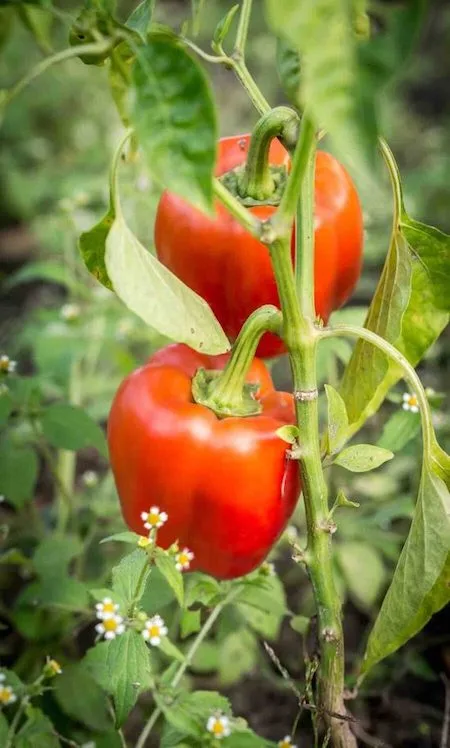Table of contents
How to Grow Capsicum from Seed in Australia
Capsicum growing is easy and a valuable part of a tropical food garden. Native to the Americas capsicum is a member of the nightshade family Solanaceae.
Capsicum comes in several varieties, such as jalapeño, peperoncini, and peperoncito. Here we are concerned with the humble capsicum, which is large and mild and is probably sold at your local supermarket.
Following this capsicum growing guide should help you grow a healthy crop!
Capsicum plants have various names depending on place and type. They are also known as bell peppers or peppers.
Capsicum Growing from Seed
Growing capsicum from seed can be a rewarding experience! Here’s a step-by-step guide to help you get started:
Time needed: 3 minutes
How to grow capsicum.
- Sow Seeds
Soak seeds overnight and the next day sow them half a centimetre deep and 25cm (10in) apart. Also, place 2-3 seeds in each hole.
- Sun and Water
Plant in a location that has full sun. They will need at least 2.5cm (1inch) of water per week. It is better to give them a thorough soaking twice or even three times a week (depending on the weather).
- Thin Seedlings and Stake
Thin out your seedlings, so your plants are now about 50cm (20in) apart. As they grow, you may want to use tomato stakes and ties to keep the plants upright (so they don’t blow over in the wind).
- Fertilise
Apply a balanced fertiliser. Over fertilising will result in an overgrown healthy looking vine that fails to produce fruit.
- Harvest
At 10-12 weeks, the fruit ripens and changes colour. However, you can harvest the capsicum fruit whenever you want, as you do not have to wait until the fruit is full size.
Growing Capsicum in Pots
Capsicum prefer to be planted in the ground or in container beds or large pots. In the tropics it is a good idea to grow in a container or raised bed that will drain well.
If you do grow capsicum in a pot, they should be in a potting mix, and make sure the pot has holes for drainage.
Normally pots will need to be watered more often than ground plants, but if you use a Green Smart wicking bed, you can get the best of both worlds as when the topsoil dries out, your plant can still access water from the reservoir of the pot.
How to Grow Capsicum from Capsicum
When collecting seeds, first make sure the calcium has fully ripened. Then scoop out the seeds and lay them on a paper towel. Once they are completely dry, store your seeds in an envelope in a cool dry place.
Then you can grow your capsicum from seed as outlined above.
Capsicum Growing Season
In tropical regions of Australia capsicum grows well in the cooler part of the year known as the ‘dry season’. We hope the following growing tips are also of use.
Capsicum Growing Tips
Soil
Capsicum can be grown in a wide range of soils. Sandy loams or alluvial soils are fine. The main thing is that the soil is deep and free draining. It is good to have a high content of organic matter in the soil, so don’t be afraid to work in heaps of compost before planting.
Fertilising
Use a fertiliser rich in nitrogen, phosphate and potassium. Be sure to apply the fertiliser to the base of the plant so you do not burn the leaves.
Water and Capsicum Growing
Capsicum needs 2.5cm (1in) of water each week. Water twice a week, so a deep watering occurs. Hence you are sure to get to the roots of the plant.
Capsicum Growing Time
The growing time for capsicum varies depending on the climate and variety but generally spans 60-90 days from transplanting to harvest.
In general, capsicum plants yield their first harvest about 8-10 weeks after transplanting and will continue to produce fruit throughout the warm season.
Capsicum Growing Problems
Insect pests and diseases are more of a problem during the wet season. This is due to the hot humid conditions.
Fruit flies, blossom end rot and root-knot nematodes can be a problem. Leaf eating beetles and aphids are also pests in the tropics. However, you can pick these from your vine at home, or if the challenge is bigger you can use an insecticide.
However, regular application of ‘white oil’ can help address these pests. Indeed white oil is an effective organic pesticide that you can make at home.
Neem oil is another organic solution you can apply. It will help to combat certain insects and fungal diseases.

Capsicum Growing Season
The best time to grow capsicum in the tropics is during the ‘dry season’. We suggest growing from May to October to give you the best chance of success.
Eating Capsicum
Capsicums are cultivated worldwide and used in many cuisines. They are very versatile in nature and can be eaten both cooked and raw.
Health Benefits
Capsicum is a very healthy vegetable to eat, raw or cooked. It can help with weight problems, gut health and constipation.
Weight Loss
Eating capsicum can help keep your blood sugar stable. Indeed the fibre in this plant can lower blood sugar by slowing the rate of digestion and absorption of sugar in the body. Consequently, this slower absorption keeps blood sugar levels steady and prevents spikes and crashes.
Fibre
Capsicum is very high in fibre that is low in calories. This is good for digestion and bowel function.
Fibre may also help lower your LDL, or “bad” cholesterol and reduce your blood pressure and decrease your chance of cardiovascular disease.
Immune System
The high levels of Vitamin C also make this vegetable a valuable food in boosting your immunity.
Antioxidants
Antioxidants in capsicum, help to combat free radicals in your body. These free-radicals can damage cells and can lead to disease, so eating capsicum can help you stay well.
Prebiotics
Capsicum is also a great source of prebiotic fibre that will have a positive effect on your gut health.
All of the capsicum growing tips above are worth the effort when it results in tasty produce that is good for your health.
Other Tropical Vegetables
- Cucumber
- Eggplant
- Jicama
- Kangkong
- Malabar Spinach
- Pak Choi
- Perpetual Spinach
- Pumpkin Growing
- Snake Beans Growing
- Sweet Potato
- Tatsoi



Comments
3 responses to “Capsicum Growing Guide”
[…] Capsicum […]
[…] Capsicum […]
[…] Capsicum […]